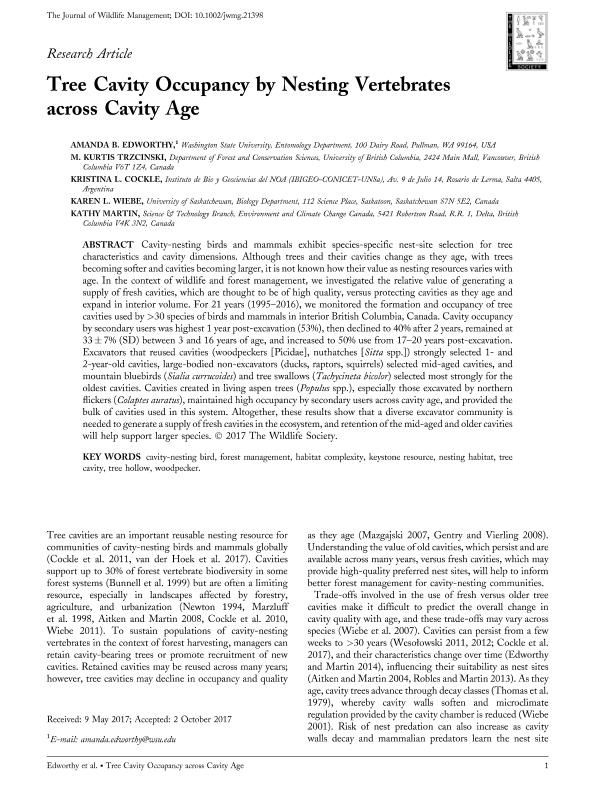Artículo
Tree cavity occupancy by nesting vertebrates across cavity age
Fecha de publicación:
04/2018
Editorial:
Wildlife Society
Revista:
Journal of Wildlife Management
ISSN:
0022-541X
Idioma:
Inglés
Tipo de recurso:
Artículo publicado
Clasificación temática:
Resumen
Cavity-nesting birds and mammals exhibit species-specific nest-site selection for tree characteristics and cavity dimensions. Although trees and their cavities change as they age, with trees becoming softer and cavities becoming larger, it is not known how their value as nesting resources varies with age. In the context of wildlife and forest management, we investigated the relative value of generating a supply of fresh cavities, which are thought to be of high quality, versus protecting cavities as they age and expand in interior volume. For 21 years (1995–2016), we monitored the formation and occupancy of tree cavities used by >30 species of birds and mammals in interior British Columbia, Canada. Cavity occupancy by secondary users was highest 1 year post-excavation (53%), then declined to 40% after 2 years, remained at 33 ± 7% (SD) between 3 and 16 years of age, and increased to 50% use from 17–20 years post-excavation. Excavators that reused cavities (woodpeckers [Picidae], nuthatches [Sitta spp.]) strongly selected 1- and 2-year-old cavities, large-bodied non-excavators (ducks, raptors, squirrels) selected mid-aged cavities, and mountain bluebirds (Sialia currucoides) and tree swallows (Tachycineta bicolor) selected most strongly for the oldest cavities. Cavities created in living aspen trees (Populus spp.), especially those excavated by northern flickers (Colaptes auratus), maintained high occupancy by secondary users across cavity age, and provided the bulk of cavities used in this system. Altogether, these results show that a diverse excavator community is needed to generate a supply of fresh cavities in the ecosystem, and retention of the mid-aged and older cavities will help support larger species.
Archivos asociados
Licencia
Identificadores
Colecciones
Articulos(IBIGEO)
Articulos de INST.DE BIO Y GEOCIENCIAS DEL NOA
Articulos de INST.DE BIO Y GEOCIENCIAS DEL NOA
Citación
Edworthy, Amanda B.; Trzcinski, M. Kurtis; Cockle, Kristina Louise; Wiebe, Karen L.; Martin, Kathy; Tree cavity occupancy by nesting vertebrates across cavity age; Wildlife Society; Journal of Wildlife Management; 82; 3; 4-2018; 639-648
Compartir
Altmétricas




